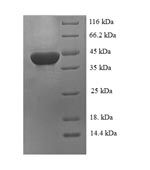Recombinant Rat Carbonic anhydrase 1 (Ca1) gets expressed in E. coli and covers the full length of the mature protein from amino acids 2 to 261. The product comes with an N-terminal 6xHis-SUMO tag that makes purification and detection more straightforward. SDS-PAGE analysis shows a purity level greater than 90%. Research applications requiring precise protein characterization appear to be the main target for this product.
Carbonic anhydrase 1 (Ca1) catalyzes the reversible hydration of carbon dioxide to bicarbonate and protons. The enzyme seems to play a crucial role in regulating pH and ion balance in tissues. Various physiological processes likely depend on its function. Biochemical researchers find Ca1's activity and regulatory mechanisms particularly interesting since they may provide insights into metabolic pathways and potential therapeutic targets.
Potential Applications
Note: The applications listed below are based on what we know about this protein's biological functions, published research, and experience from experts in the field. However, we haven't fully tested all of these applications ourselves yet. We'd recommend running some preliminary tests first to make sure they work for your specific research goals.
Rat Ca1 is a zinc metalloenzyme that requires precise folding, proper zinc ion coordination, and specific active site formation for its catalytic activity in CO₂ hydration. The E. coli expression system can produce functional carbonic anhydrase when zinc is supplemented, but the large N-terminal 6xHis-SUMO tag (∼15 kDa) may sterically interfere with the protein's active site or oligomerization interfaces. While E. coli can fold some carbonic anhydrases correctly with zinc supplementation, the probability of correct folding with full enzymatic activity requires experimental validation, particularly given the potential tag interference.
1. Carbonic Anhydrase Enzyme Kinetics and Inhibitor Screening
This application carries a significant risk without functional validation. CA1 enzymatic activity requires precise zinc coordination and active site formation that may be compromised by the large N-terminal tag. If correctly folded and zinc-bound (verified through activity assays), the protein may be suitable for kinetic studies. If misfolded/inactive (unverified), kinetic measurements and inhibitor screening will yield biologically meaningless results. The SUMO tag may sterically block inhibitor access to the active site.
2. Antibody Development and Validation
This application is highly suitable as antibody development relies on antigenic sequence recognition rather than functional enzymatic activity. The full-length mature protein provides comprehensive epitope coverage for generating antibodies against rat CA1. The high purity (>90%) ensures minimal contamination-related issues during immunization protocols.
3. Protein-Protein Interaction Studies
This application requires proper folding validation. CA1 interactions with other proteins require native conformation. If correctly folded (verified), the protein may identify physiological interaction partners. If misfolded/unverified, there is a high risk of non-specific binding or failure to replicate genuine protein interactions. The large SUMO tag may create artificial interaction surfaces.
4. Comparative Species Analysis and Evolutionary Studies
Meaningful comparative studies require native enzyme conformation and functional activity. If correctly folded and active (verified), the protein enables valid evolutionary comparisons of catalytic properties across species. If misfolded/inactive (unverified), comparative analyses would yield misleading evolutionary insights about CA1 function and adaptation.
Final Recommendation & Action Plan
The E. coli expression system can potentially produce functional carbonic anhydrase with zinc supplementation, but the large N-terminal 6xHis-SUMO tag poses a significant risk of interfering with enzymatic activity. Begin with enzymatic activity validation using standard CO₂ hydration assays and zinc content analysis before any functional applications. Applications 2 (antibody development) can proceed immediately. For Applications 1, 3, and 4, first confirm proper folding and catalytic activity. Consider tag removal or using smaller-tag constructs for critical kinetic and interaction studies. Always include zinc supplementation during expression and purification, and validate key findings with tag-free protein when possible.






